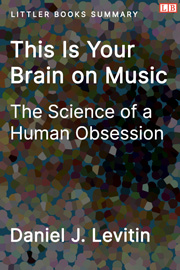Book Description
A fascinating exploration of how music affects the brain and why we as humans are so deeply connected to it.
If You Just Remember One Thing
Coming soon.
Bullet Point Summary and Quotes
- Music has been a significant aspect of human culture throughout history, evoking emotions and captivating us.
- Music can be defined as a meaningful combination of specific building blocks, including:
- Pitch: What note is played, e.g., C or G.
- Rhythm: The time between notes.
- Tempo: How fast the piece is played.
- Contour: The rise and fall of the notes.
- Timbre: The tonal characteristics of the sound. For example, a note played by a piano has a different timbre from the same note played by a guitar. Timbre is also what makes our voices unique.
- Loudness: The amount of energy created.
- Reverberation: The impression of distance or room size the sound imparts.
- The origin of music has been debated, with some arguing that it is merely a by-product of language that brings us pleasure. However, most theorists believe that music has an evolutionary basis, possibly as a precursor to speech or a means of courtship. Music may have served an adaptive purpose, signaling health, affluence, and sexual vigor that attracts mates.
- Advances in science have given us the ability to detect that nearly every part of the brain, from the newest to the most primitive, is activated when we process music, including the auditory cortex, motor cortex, amygdala, and hippocampus. These areas process in parallel to help us perceive different aspects of music, such as pitch, rhythm, melody, harmony, and lyrics.
- Musical pleasure releases dopamine, a neurotransmitter in the brain that's associated with pleasure from more tangible rewards such as food, drugs, and sex. This explains why music, which has no clear survival value, is prevalent throughout human societies.
- Research has shown that listening to music can enhance our cognitive abilities, such as attention, perception, and problem-solving skills.
- Listening to music can foster social connections as it activates brain circuits involved in empathy, trust, and cooperation.
- Our brains are wired to detect patterns and make predictions, and music satisfies this cognitive need by following certain structures and rules. The brain anticipates certain chords, melodies, and rhythms, and deviations from these expectations can create tension, release, surprise, and emotion.
- The emotional impact of music is related to our brain's ability to predict what comes next in a piece of music. The art of composition involves building tension and maintaining a balance between meeting and defying expectations. This can be done in various ways, such as through rhythm and melody. Skilled composers play with the melody's tendency to return to its starting point, disrupting expectations and then resolving them in a satisfying way.
- Recognizing a tune involves complex neural computations that interact with memory. Furthermore, studies show that we use the same brain regions for hearing music as we do for remembering music. Every time we hear a song, a specific set of neurons are fired and an imprint is created, when we imagine the song or hear it again, the same pattern of neurons are fired. Thus, songs are often associated with specific memories and can act as triggers to unlock these memories.
- Groove happens when the beat of music carries a palpable momentum. We have evolved to act emotionally to grooves, and using it to purposefully break our expectations can be an effective way for music to communicate. Our cerebellum is also activated when we perceive grooves. Since the cerebellum is responsible for balance and movement, it is evidence that human emotion and motion are linked.
- Musical expertise is dependent on practice. Studies have shown that those who are the most skilled at their instruments are those who have practiced the most -- perceived “talent” is inconsequential.
- It takes 10,000 hours of practice to master a skill.
- Genetic predisposition and environmental factors can affect musical expertise (scientists' best guess is around 50%). If you have large hands and great hand-eye coordination, then you'll be predisposed to be a good piano player. If you have poor nutrition and live in an unstable environment, then you will have a disadvantage in achieving mastery in an instrument.
- Our musical preferences begin with early exposure to music. A study has shown that babies prefer music that they've heard in the womb.
- As we get older, familiarity plays a role in what we like. It shapes our preferences as we associate music with positive experiences. While there is no cutoff point for developing new musical preferences, generally, most people have formed their tastes by the age of 18 or so.
- We prefer music that is not too simple (boring) or too complex (predictability is important).
- We tend to choose music that makes us feel safe and comfortable, as listening to music makes us vulnerable.
This Is Your Brain on Music: Resources
- Download this summary and 173+ other top nonfiction book summaries in one book (PDF, eBook, DOCX)
- Buy the book
